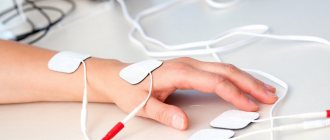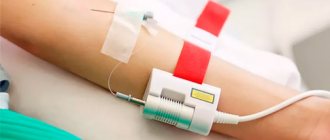Coronary heart disease is a group of acute and chronic cardiovascular diseases, which are based on impaired circulation in the coronary (heart) arteries that supply blood to the heart muscle (myocardium). IHD is one of the most common causes of mortality and disability in the population.
IHD has several forms:
- angina pectoris;
- myocardial infarction;
- chronic heart failure.
Coronary heart disease is a condition in which an imbalance between the heart muscle's need for oxygen and its delivery leads to oxygen starvation of the heart muscle and the accumulation of toxic metabolic products in the myocardium, which causes pain. The causes of impaired blood flow in the coronary arteries are atherosclerosis and vasospasm. Among the main factors causing coronary heart disease, in addition to age:
- smoking,
- obesity,
- high blood pressure (hypertension),
- uncontrolled use of medications, etc.
What is cardiac bicycle ergometry?
Professional athletes who undergo regular medical examinations are well aware of what bicycle ergometry is. But the exercise test is not only carried out within the framework of sports medicine. In cardiology, it is used to diagnose coronary heart disease even at the initial stage, when deficiency of cardiac muscle nutrition appears in the patient only during the period of activity, atherosclerosis. In pulmonology, a gas analysis test is used to identify pulmonary pathologies and lung volume.
The principle of the study is based on the fact that during physical activity the body reacts with a complex of physiological reactions. The patient's breathing and heart rate increase, oxygen consumption increases, and blood pressure increases.
Oxygen supplied to the muscles through the blood is involved in the redox reactions necessary to produce energy. The same thing happens with the heart, which is essentially a muscle. The organ is fed through the coronary vascular system. If abnormalities occur in the blood circulation, they are most pronounced during the period of physical activity.
Along with bicycle ergometry, there is a similar test in functional diagnostics: the treadmill test. The difference is that instead of bicycle ergometry during the treadmill test, the patient’s heart and blood vessels are measured during physical activity on a treadmill.
Interpretation of VEM results
Hardware data includes parameters such as:
- patient's performance level;
- heart rhythm, detected disturbances (if any);
- rate of recovery of blood pressure and heart rate;
- type of blood pressure response to exercise;
- severity of ischemia;
- time and reason for stopping testing, etc.
After interpretation of the data, the patient is given a conclusion.
There are 4 main forms of conclusion:
Negative VEM test - when the maximum load was reached, normal physiological parameters were preserved. IHD is excluded in most cases.
A positive result —the ECG shows changes indicating ischemia, often accompanied by an attack of angina.
A questionable result —the subject complained of pain, but there were no changes on the ECG.
Uninformative test - the study was not completed completely, the patient refused to continue testing due to dizziness, severe headache or convulsions, although there were no signs of coronary artery disease.
Despite all the information value of bicycle ergometry for most patients, the uncertainty of the results of a particular test may require the appointment of additional studies.
Decoding the treadmill test is practically no different from deciphering the VEM results. Normal indicators for the treadmill test, as well as the VEM test, are negative indicators.
Purpose of bicycle ergometry
The patient undergoes the study at his own discretion, on the direction of a doctor, trainer or employer. The purpose of bicycle ergometry depends on who is taking the test. In patients, the doctor uses a test to monitor the treatment process and identify diseases at an early stage.
Athletes are required to undergo regular medical examinations, which include bicycle ergometry. It helps determine the effectiveness of training, correctly dose physical activity, and diagnose hidden pathologies that can become an obstacle to work or a sports career.
Significant difference in cost
An exercise bike and a bicycle ergometer have many significant differences from each other, despite the similar basic principle of operation. One of the most obvious differences that catches your eye when you first study the proposed options is the cost of sports equipment.
Classic exercise bikes are a much more affordable option for the mass user. Prices for adequate models start from ten thousand rubles and at a maximum can reach two hundred to three hundred thousand.
With bicycle ergometers the situation is somewhat different. Due to the significantly higher complexity of the device, price tags for such models of sports equipment start from fifty thousand rubles and can easily reach seven-digit sums in the maximum price tag.
Bicycle ergometry technique
The examination of the heart and blood vessels is carried out by an experienced cardiologist. There is a specialist on duty in the office who is always ready to provide first aid if the patient’s health worsens during the test.
Tests take place in a spacious, well-lit room with a special microclimate. The room is maintained with ventilation, average atmospheric pressure, temperature 21 degrees, low humidity, insulation from noise and extraneous contacts.
The room is equipped with a bicycle ergometer - an exercise bike with a stepwise increasing load and an electrocardiograph for monitoring the patient’s heart rhythm. The office also contains a device for measuring blood pressure.
The office also has a couch, a defibrillator and a first aid pharmacy.
The test takes no more than 20 minutes, otherwise the patient will get tired. Before the test begins, the doctor records your weight and height, blood pressure, and resting heart rate. The patient sits on a bicycle ergometer and electrodes are attached to his body. Blood pressure control is carried out by an automated system.
The cardiologist selects the study protocol depending on the indications. Test methods depend on how the load is applied:
- continuous throughout the test;
- intermittent with a gradual increase in load and rest intervals;
- continuously increasing without pauses;
Electrocardiogram monitoring begins before the start of the test and ends after its completion. Monitoring of pressure and heart rate is carried out at each stop or at intervals of 2 minutes.
The optimal pedaling speed is 60 rpm: at it the level of aerobic exercise is maximum. But not all patients can withstand this speed. In this regard, the doctor, before starting the test, determines the upper limit of the power of the bicycle ergometer, based on the capabilities of the subject and based on special formulas.
If the patient cannot achieve the maximum power of the exercise bike, additional criteria for ending the test are provided: severe physical fatigue or the appearance of clinical symptoms requiring load limitation. The criteria include a decrease or increase in pressure, cyanosis of the skin, shortness of breath, dizziness, muscle pain, chest pain, and pronounced changes in heart rhythm. The listed symptoms in the patient that appeared during the study indicate the presence of cardiovascular pathology.
Horizontal, vertical, hybrid - elliptical trainers
When choosing a bicycle ergometer, experts advise paying attention to:
- type of seat mounting (vertical or horizontal);
- ergonomics (shape and adjustability of the steering wheel, seat; comfort of pedal platforms);
- method of measuring pulse (telemetry or built-in heart rate sensors);
- user weight limit;
- type of power supply (autonomous or volatile);
- additional amenities (stands, multimedia capabilities, etc.).
Horizontal bicycle ergometers are optimal for use in medical institutions for medical and rehabilitation purposes. The comfortable chair of the exercise machine is laid back and is located in the same horizontal plane with the pedals. Thanks to this, the load is removed from the back muscles and transferred to the leg muscles.
The preferred choice of horizontal simulator is:
- for gentle training for diseases of the spine and neck;
- to strengthen the cardiovascular system and increase the body's endurance;
- to lose a lot of excess weight.
In vertical bicycle ergometers, the pedals are located directly under the seat, so that the legs are in a vertical position during exercise.
The advantages of such simulators include:
- small dimensions (such sports equipment can be installed even at home);
- lower cost in comparison with horizontal analogues;
- the ability to conduct intense (but not many hours) training, including for burning fat deposits.
In addition, there are hybrid models in which it is possible to vary the seat position in different planes. But so far, not all manufacturers produce such universal simulators. Yes, and they cost a lot of money.
Iron King is a reliable supplier of exercise equipment and equipment for gyms and fitness centers. Among the professional and semi-professional models we recommend is the VISION U40 CLASSIC bicycle ergometer
. Featuring an ergonomic ComfortArc™ seat and adjustable handlebar settings, this upright model is suitable for use in small commercial or home gyms. The device, developed by one of the largest American companies producing sports equipment, Johnson Health Tech, has 5 programs (including one heart rate-dependent), records speed, time, distance, calorie expenditure, pace, pulse and energy power of exercise in watts. To measure pulse there are touch sensors and a Polar receiver. The maximum user weight is limited to 148 kg. VISION U40 CLASSIC is powered from a regular power supply.
For gyms with average and high traffic levels, a professional German bicycle ergometer Bronze Gym U901 PRO with a vertical fit from Neotren GmbH (Germany) is suitable.
Bicycle ergometer Bronze Gym U901 PRO from Neotren GmbH
The ergonomic helium-filled seat can be adjusted horizontally and vertically. The multi-position steering wheel is equipped with armrests and dual heart rate sensors. The electromagnetic load ensures smooth, silent operation of the device. A user of any level of training can choose a suitable training program from 22 included in the computer. The maximum user weight is 180 kg. Powering the device does not require a connection to the network.
Another American professional-level cardio machine from Johnson Health Tech, the VISION S60 bicycle ergometer, is also suitable for medium- and high-traffic gyms.
VISION S60 bicycle ergometer from Johnson Health Tech
Like its predecessor VISION U40 CLASSIC, this ellipse has an upright seating position, an ergonomic seat, touch sensors and a Polar receiver for measuring heart rate. Equipped with a multifunctional training computer, maximally informative, with simple and clear navigation. However, the maximum user weight limit for this model is 182 kg. And non-volatile power does not require a network connection.
The powerful professional bicycle ergometer Matrix E1X (E1X-02) from the American company Johnson Health Tech is the most expensive vertical premium model presented in the IK catalogue.
Matrix E1X (E1X-02) bicycle ergometer from Johnson Health Tech
Like any device in this segment, it has a perfectly smooth ride. Orthopedic pedals automatically adjust to a comfortable foot position for the trainee. Thirteen training modes (including two pulse-dependent), autonomous power supply, maximum weight limit of 192 kg - all this one way or another relates to well-known characteristics. However, Matrix E1X (E1X-02) has another interesting function - the ability to connect to the cardiotheater system. This system is nothing more than a specially selected set of multimedia components for high-quality sound and image reproduction, which will create additional comfort during training.
Bicycle ergometry: indications and contraindications
Cardiac examinations are prescribed for certain indications. Indications for bicycle ergometry are:
- complaints of chest pain in the absence of abnormalities in the cardiogram;
- hereditary cardiovascular diseases;
- previous cardiac surgery in adolescents and children (to assess effectiveness);
- suspicion of atherosclerosis or coronary heart disease;
- myocardial infarction (3 weeks after the illness);
- heart failure;
- heart rhythm disturbances;
- heart valve pathology;
- bronchopulmonary diseases;
- pathologies of blood vessels of the lower extremities.
Bicycle ergometry also has absolute contraindications when the test is dangerous to the patient’s life. Such conditions include aortic valve stenosis, angina pectoris, aortic aneurysm, inflammatory pathologies of the heart, acute or chronic diseases in the acute stage, and circulatory disorders in the brain. The test is not performed in the first 3 weeks after the onset of signs of myocardial infarction.
LET'S SUM IT UP
Bicycle ergometers, to describe them simply and briefly, are more accurate exercise bikes with the ability to more flexibly control loads and a number of additional functions. They are indispensable for rehabilitation, which is why they are often used in specialized institutions. If your goal is regular fitness, then you most likely will not need them, especially since their price is much higher than traditional devices. But if you have experienced or are still experiencing health problems, then you should definitely think about either exercising on such simulators in medical institutions, or purchasing them for home.
SOURCES: https://bodybuilding-and-fitness.ru/kardio/kardiotrenazhery/veloehrgometr.html https://proskopiyu.ru/metody/veloergometr.html
Bicycle ergometry: how to prepare
For maximum reliability of the results, the patient is required to prepare:
- During the day, do not drink coffee, alcoholic beverages, or smoke.
- On the day of testing, avoid stress and any physical activity.
- Breakfast the morning before the test should be light.
- Do not take medications that affect heart function or blood pressure. The doctor makes the decision about this.
To get reliable test results, make an appointment with a cardiologist at our medical center. The doctor will tell you in detail what bicycle ergometry shows, how the test is performed and how to prepare for it.
In our center, consultations are conducted by qualified doctors who have extensive experience in diagnosing and treating cardiovascular diseases. The latest Swiss equipment and spacious rooms make the test comfortable and the results reliable.
To undergo bicycle ergometry at an affordable price, make an appointment by phone at a convenient time. Patients can fill out an application on the website for the test, and operators will select a time for a visit to a cardiologist.
Features of projectile maintenance
The difference in technical design imposed certain differences in equipment maintenance. Bicycle ergometers have a significantly larger number of sensors and precision electronics, which leads to a more complex design. As a rule, any repair or scheduled maintenance work must be carried out only by certified technicians.
Classic exercise bikes, especially budget models, have a simple design designed for regular, simplified maintenance. This allows the user who purchased such equipment for home exercises to maintain it on their own.










